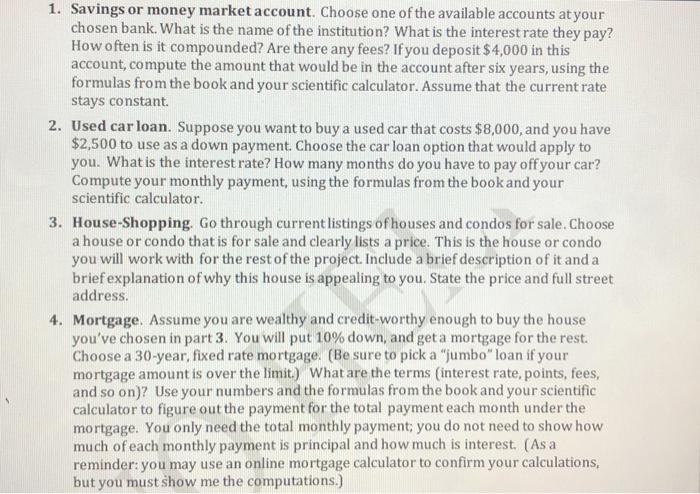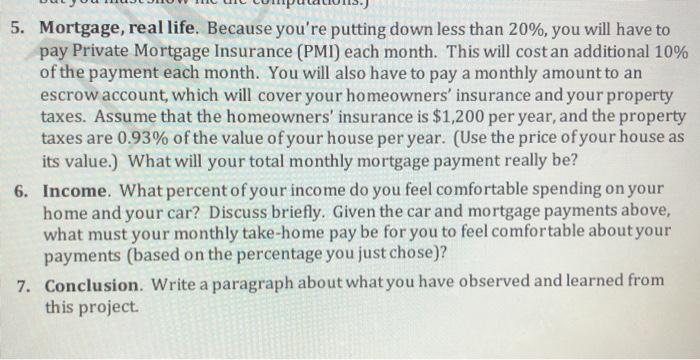1. Savings or money market account. Choose one of the available accounts at your chosen bank. What is the name of the institution? What is the interest rate they pay? How often is it compounded? Are there any fees? If you deposit $4,000 in this account, compute the amount that would be in the account after six years, using the formulas from the book and your scientific calculator. Assume that the current rate stays constant 2. Used car loan. Suppose you want to buy a used car that costs $8,000, and you have $2,500 to use as a down payment. Choose the car loan option that would apply to you. What is the interest rate? How many months do you have to pay off your car? Compute your monthly payment, using the formulas from the book and your scientific calculator. 3. House-Shopping. Go through current listings of houses and condos for sale. Choose a house or condo that is for sale and clearly lists a price. This is the house or condo you will work with for the rest of the project. Include a brief description of it and a brief explanation of why this house is appealing to you. State the price and full street address. 4. Mortgage. Assume you are wealthy and credit-worthy enough to buy the house you've chosen in part 3. You will put 10% down, and get a mortgage for the rest. Choose a 30-year, fixed rate mortgage. (Be sure to pick a "jumbo" loan if your mortgage amount is over the limit.) What are the terms (interest rate, points, fees, and so on)? Use your numbers and the formulas from the book and your scientific calculator to figure out the payment for the total payment each month under the mortgage. You only need the total monthly payment, you do not need to show how much of each monthly payment is principal and how much is interest. (As a reminder: you may use an online mortgage calculator to confirm your calculations, but you must show me the computations.) 5. Mortgage, real life. Because you're putting down less than 20%, you will have to pay Private Mortgage Insurance (PMI) each month. This will cost an additional 10% of the payment each month. You will also have to pay a monthly amount to an escrow account, which will cover your homeowners' insurance and your property taxes. Assume that the homeowners' insurance is $1,200 per year, and the property taxes are 0.93% of the value of your house per year. (Use the price of your house as its value.) What will your total monthly mortgage payment really be? 6. Income. What percent of your income do you feel comfortable spending on your home and your car? Discuss briefly. Given the car and mortgage payments above, what must your monthly take-home pay be for you to feel comfortable about your payments (based on the percentage you just chose)? 7. Conclusion. Write a paragraph about what you have observed and learned from this project. 1. Savings or money market account. Choose one of the available accounts at your chosen bank. What is the name of the institution? What is the interest rate they pay? How often is it compounded? Are there any fees? If you deposit $4,000 in this account, compute the amount that would be in the account after six years, using the formulas from the book and your scientific calculator. Assume that the current rate stays constant 2. Used car loan. Suppose you want to buy a used car that costs $8,000, and you have $2,500 to use as a down payment. Choose the car loan option that would apply to you. What is the interest rate? How many months do you have to pay off your car? Compute your monthly payment, using the formulas from the book and your scientific calculator. 3. House-Shopping. Go through current listings of houses and condos for sale. Choose a house or condo that is for sale and clearly lists a price. This is the house or condo you will work with for the rest of the project. Include a brief description of it and a brief explanation of why this house is appealing to you. State the price and full street address. 4. Mortgage. Assume you are wealthy and credit-worthy enough to buy the house you've chosen in part 3. You will put 10% down, and get a mortgage for the rest. Choose a 30-year, fixed rate mortgage. (Be sure to pick a "jumbo" loan if your mortgage amount is over the limit.) What are the terms (interest rate, points, fees, and so on)? Use your numbers and the formulas from the book and your scientific calculator to figure out the payment for the total payment each month under the mortgage. You only need the total monthly payment, you do not need to show how much of each monthly payment is principal and how much is interest. (As a reminder: you may use an online mortgage calculator to confirm your calculations, but you must show me the computations.) 5. Mortgage, real life. Because you're putting down less than 20%, you will have to pay Private Mortgage Insurance (PMI) each month. This will cost an additional 10% of the payment each month. You will also have to pay a monthly amount to an escrow account, which will cover your homeowners' insurance and your property taxes. Assume that the homeowners' insurance is $1,200 per year, and the property taxes are 0.93% of the value of your house per year. (Use the price of your house as its value.) What will your total monthly mortgage payment really be? 6. Income. What percent of your income do you feel comfortable spending on your home and your car? Discuss briefly. Given the car and mortgage payments above, what must your monthly take-home pay be for you to feel comfortable about your payments (based on the percentage you just chose)? 7. Conclusion. Write a paragraph about what you have observed and learned from this project








